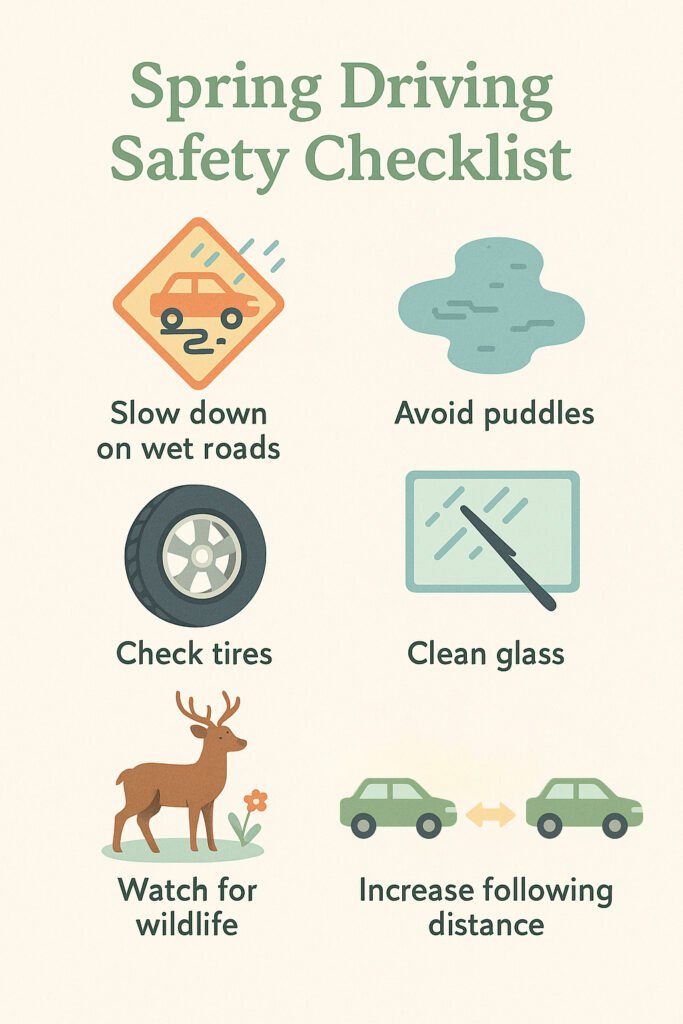Spring Driving in Nova Scotia
Spring driving in Nova Scotia brings more than sunshine and melting snow — it brings a new set of hazards. Changing temperatures, wet roads, potholes, and strong winds mean your winter driving habits won’t be enough. This is the season where defensive driving really matters.
Here’s how to adjust your driving for spring conditions, avoid seasonal hazards, and stay safe during one of the most unpredictable times of year on the road.
Table of Contents
- Why Spring Driving in Nova Scotia Requires Adjustments
- Key Driving Habits for Spring Roads
- Common Mistakes During Spring Driving
- Dealing with Nova Scotia’s Spring Winds
- A Reminder on Defensive Driving in Spring
- Final Thought
Why Spring Driving in Nova Scotia Requires Adjustments
Spring may look safer than winter, but it can be just as risky. Rain, fog, potholes, and glare create conditions that change hour by hour. The mindset of spring driving in Nova Scotia needs to be alert and flexible. Roads are still recovering, and drivers are too.
Key Driving Habits for Spring Roads
1. Watch for Rain and Wet Pavement
Nova Scotia spring driving often means navigating slick roads. Reduce your speed, avoid large puddles, and never use cruise control when it’s raining. Hydroplaning can happen fast, especially on roads that still have winter wear.
2. Slow Down for Potholes
Spring is pothole season. They can appear overnight and cause real damage. Reduce speed in known trouble spots and give plenty of space between you and the vehicle ahead — it helps you spot road damage in time.
3. Replace Wipers and Clean Windows
Good visibility is essential for safe spring driving. Replace old wipers, clean all windows, and remove winter grime from headlights. Glare is worse when your windshield is dirty — and spring glare can be brutal in early morning and late afternoon.
4. Prepare for Wildlife and Pedestrians
As temperatures rise, you’ll see more pedestrians, cyclists, and animals near the road. Stay alert in rural zones, parks, and neighborhoods. Signal early, and give extra space when passing walkers or bikers.

Common Mistakes During Spring Driving
Even experienced drivers slip up when seasons change. Here are the most common mistakes we see with spring driving in Nova Scotia:
- Rushing into summer mode: Just because there’s no snow doesn’t mean it’s smooth sailing. Spring is full of surprises.
- Speeding through standing water: You risk losing traction or hitting a hidden pothole.
- Ignoring tire health: Check your pressure weekly and ensure your tread is solid — spring roads demand grip.
- Overconfidence after winter: A “back to normal” attitude can lead to carelessness. Stay sharp.
Dealing with Nova Scotia’s Spring Winds
It’s not just rain and potholes — spring driving in Nova Scotia often comes with strong winds. Gusts can hit 40–60 km/h or more, especially in coastal and open rural areas. High-profile vehicles like vans and SUVs are most affected, but any car can get pushed.
To drive safely in spring wind:
- Use two hands on the wheel
- Stay centered in your lane
- Slow slightly when passing large vehicles
- Watch for debris or tree branches on the road
Check Nova Scotia’s official weather alerts before long drives — strong wind warnings are common in spring.
A Reminder on Defensive Driving in Spring
Spring driving conditions call for more than caution — they call for defensive awareness. That means:
- Looking 12–15 seconds ahead
- Scanning mirrors frequently
- Leaving a space cushion between vehicles
- Staying patient during road repairs or delays
If you’re new to these habits — or just need a refresher — check out our Defensive Driving Course. It’s built for real Nova Scotia conditions, spring included.
Final Thought
Spring driving in Nova Scotia means being flexible, focused, and aware. Don’t let better weather lull you into auto-pilot. As the roads shift with the season, your mindset needs to shift too.
Drive for the conditions, not the calendar — and you’ll make it through the season with less stress and fewer surprises.
The information provided on this post is for general informational purposes only and is not intended to serve as professional advice or guidance. While Artin Driving School strives to ensure the accuracy and timeliness of the information shared, Artin Driving School makes no guarantees, warranties, or representations regarding the completeness, reliability, or suitability of any content posted.





